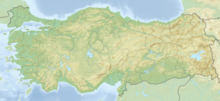Cafer Höyük
Coordinates: 38 ° 24 '43 " N , 38 ° 42' 35" E
Cafer Höyük is a Neolithic site on the Upper Euphrates in Turkey in the Malatya province . The site was excavated from 1979 to 1986 under the direction of Oliver Aurenche and Jacques Cauvin . It turned out that the place experienced a total of three settlement phases.
The first phase of settlement existed around the year 8000 BC. From rectangular adobe buildings. The building material was simply dried in the air. Inside, the buildings were divided into several rooms that were connected to one another. From this phase also some small devices originate , which were mainly made from obsidian and show connections to the Caucasus as well as to the Levant . The cultivation of legumes can already be proven in this early phase.
The second phase of settlement existed in the first half of the 8th millennium BC. During this phase, the buildings were expanded to include a basement in cell plan construction , similar to that in Cayönü . Between the buildings there were presumably uncovered courtyards. In this phase, stone tools increasingly had blades. Fine stone vessels and four clay figurines also originate from this phase .
The third phase belongs to the second half of the 8th millennium BC. Here the buildings from the previous phase continued to exist, but show a clearer division into rooms. The foundations of these buildings were formed by large pebbles on which rising mud brick walls then stood. In the course of this phase, the position of the houses in relation to one another changed, so that at times they were built directly next to one another and at times narrow alleys existed between them. Towards the center, these streets narrow increasingly, so that the settlement here becomes denser overall.
The obsidian found in the settlement was brought in from deposits around 200 kilometers away. In addition, marble and basalt played a major role as material for tool manufacture. No evidence of cattle breeding could be found, so that Cafer Höyük can probably be considered a farming village, but its inhabitants also went hunting.
The place is now flooded by the Karakaya Reservoir , which was built in the late 1980s . The finds are exhibited in the Malatya Archaeological Museum .
literature
- Jaques Chauvin, Oliver Aurenche et al: The Pre-pottery site of Cafer Höyük , in: Mehmet Özdoğan, Nezih Başgelen (ed.): Neolithic in Turkey. The cradle of civilization , Istanbul 1999, ISBN 975-6899-41-7 , pp. 87-103.

